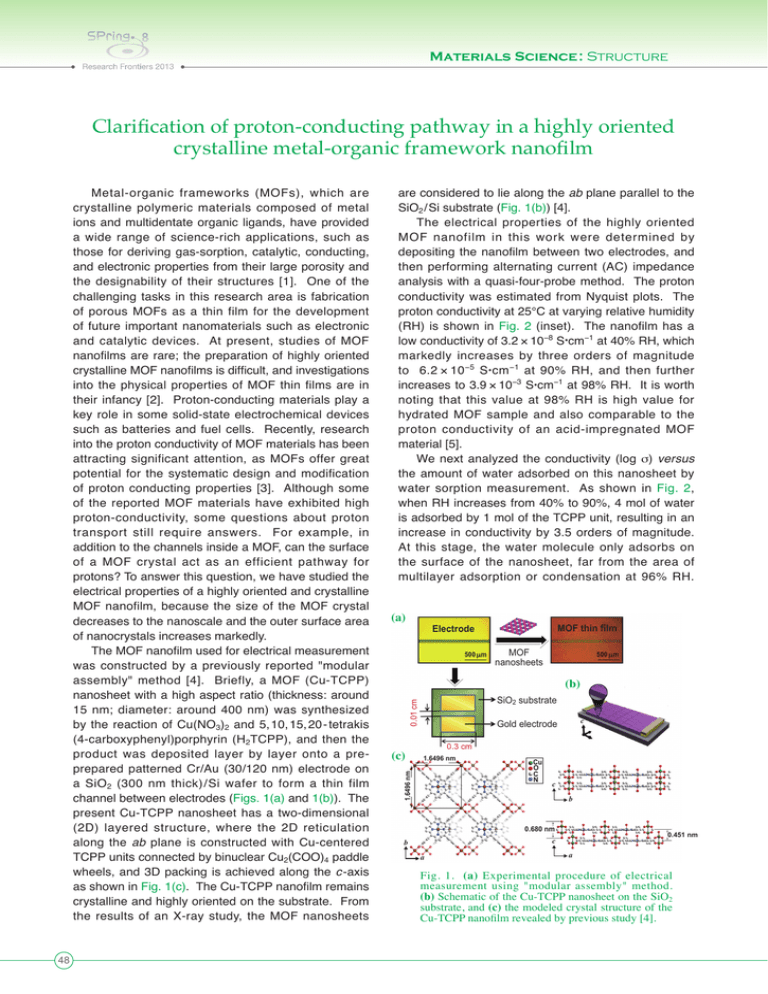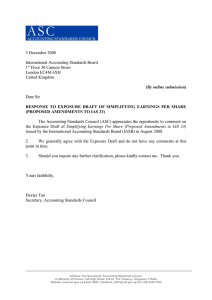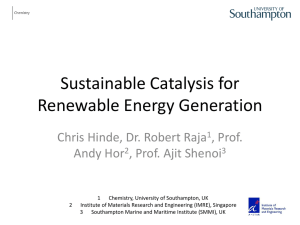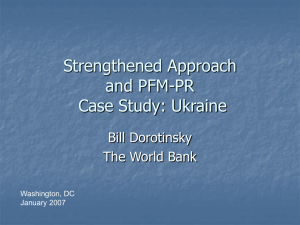Clarification of proton-conducting pathway in a highly - SPring-8
advertisement

Materials Science: Structure Clarification of proton-conducting pathway in a highly oriented crystalline metal-organic framework nanofilm 48 are considered to lie along the ab plane parallel to the SiO2 /Si substrate (Fig. 1(b)) [4]. The electrical properties of the highly oriented MOF nanofilm in this work were determined by depositing the nanofilm between two electrodes, and then performing alternating current (AC) impedance analysis with a quasi-four-probe method. The proton conductivity was estimated from Nyquist plots. The proton conductivity at 25°C at varying relative humidity (RH) is shown in Fig. 2 (inset). The nanofilm has a low conductivity of 3.2 × 10−8 S•cm−1 at 40% RH, which markedly increases by three orders of magnitude to 6.2 × 10 −5 S • cm −1 at 90% RH, and then further increases to 3.9 × 10−3 S•cm−1 at 98% RH. It is worth noting that this value at 98% RH is high value for hydrated MOF sample and also comparable to the proton conductivity of an acid-impregnated MOF material [5]. We next analyzed the conductivity (log σ) versus the amount of water adsorbed on this nanosheet by water sorption measurement. As shown in Fig. 2, when RH increases from 40% to 90%, 4 mol of water is adsorbed by 1 mol of the TCPP unit, resulting in an increase in conductivity by 3.5 orders of magnitude. At this stage, the water molecule only adsorbs on the surface of the nanosheet, far from the area of multilayer adsorption or condensation at 96% RH. (a) MOF thin film Electrode 500 μm MOF nanosheets 500 μm (b) 0.01 cm SiO2 substrate (c) c Gold electrode 0.3 cm 1.6496 nm 1.6496 nm Metal-organic frameworks (MOFs), which are crystalline polymeric materials composed of metal ions and multidentate organic ligands, have provided a wide range of science-rich applications, such as those for deriving gas-sorption, catalytic, conducting, and electronic properties from their large porosity and the designability of their structures [1]. One of the challenging tasks in this research area is fabrication of porous MOFs as a thin film for the development of future important nanomaterials such as electronic and catalytic devices. At present, studies of MOF nanofilms are rare; the preparation of highly oriented crystalline MOF nanofilms is difficult, and investigations into the physical properties of MOF thin films are in their infancy [2]. Proton-conducting materials play a key role in some solid-state electrochemical devices such as batteries and fuel cells. Recently, research into the proton conductivity of MOF materials has been attracting significant attention, as MOFs offer great potential for the systematic design and modification of proton conducting properties [3]. Although some of the reported MOF materials have exhibited high proton-conductivity, some questions about proton transport still require answers. For example, in addition to the channels inside a MOF, can the surface of a MOF crystal act as an efficient pathway for protons? To answer this question, we have studied the electrical properties of a highly oriented and crystalline MOF nanofilm, because the size of the MOF crystal decreases to the nanoscale and the outer surface area of nanocrystals increases markedly. The MOF nanofilm used for electrical measurement was constructed by a previously reported "modular assembly" method [4]. Briefly, a MOF (Cu-TCPP) nanosheet with a high aspect ratio (thickness: around 15 nm; diameter: around 400 nm) was synthesized by the reaction of Cu(NO3)2 and 5, 10, 15, 20 - tetrakis (4-carboxyphenyl)porphyrin (H2TCPP), and then the product was deposited layer by layer onto a preprepared patterned Cr/Au (30/120 nm) electrode on a SiO 2 (300 nm thick)/Si wafer to form a thin film channel between electrodes (Figs. 1(a) and 1(b)). The present Cu-TCPP nanosheet has a two-dimensional (2D) layered structure, where the 2D reticulation along the ab plane is constructed with Cu-centered TCPP units connected by binuclear Cu2(COO)4 paddle wheels, and 3D packing is achieved along the c -axis as shown in Fig. 1(c). The Cu-TCPP nanofilm remains crystalline and highly oriented on the substrate. From the results of an X-ray study, the MOF nanosheets Cu O C N c b 0.680 nm 0.451 nm c b a a Fig. 1. (a) Experimental procedure of electrical measurement using "modular assembly" method. (b) Schematic of the Cu-TCPP nanosheet on the SiO2 substrate, and (c) the modeled crystal structure of the Cu-TCPP nanofilm revealed by previous study [4]. In the RH range of 90% – 96%, the uptake of water suddenly increases to 34 H2O / TCPP unit. At this high uptake, the conductivity reaches saturation and the conductivity increases slightly by about 1 order of magnitude. Considering that the proton conductivity strongly depends on RH and water adsorbs on the mesopores or macropores in the nanosheets, we may deduce that the hydrogen bonding network that acts as the pathway for proton transport is created by the water adsorbed, dangling coordination water, and dangling carboxyl groups of the nanosheets (Fig. 1(c)); therefore, it should be located within the mesopores or macropores, and/or on the surfaces of the nanosheets. To clarify the proton-conducting pathway of the present Cu-TCPP nanosheet, in situ synchrotron X-ray diffraction (XRD) measurements under varying RH conditions were carried out at beamline BL13XU. Figure 3 shows synchrotron XRD patterns (λ = 1.550 Å, rt) of the Cu-TCPP nanosheet both in the horizontal (in-plane, grazing-incidence mode (GIXRD); Fig. 3(a)) and vertical (out-of-plane, θ – 2θ mode (XRD); Fig. 3(b)) directions relative to the substrate under varying RH conditions. As shown in Fig. 3, no significant changes under varying humidity were observed in both the GIXRD and XRD patterns of the nanofilm, indicating that the nanofilm remains intact at a high humidity. The constant GIXRD patterns with varying RH also exclude the possibility of a "gate-opening" effect in this 2D MOF under high humidity condition. The results of synchrotron X-ray studies clearly indicate that the small amount of water adsorbed before 90% RH is sufficient to create an efficient pathway on the surface of the nanosheet for proton transport, exerting control over most of the change in proton conductivity. Hence, the surface of the CuTCPP nanosheet, which contains numerous dangling groups (Fig. 1(c)), should play a dominant role in constructing the proton pathway. The unusually high conductivity of this MOF thin film may arise from the numerous dangling groups on the surface of the nanosheet and the highly oriented crystalline morphology of the thin film. The size effect of the nanosheets used to fabricate the thin film should also be considered. The dimensions of the Cu-TCPP crystal are within the nanoscale; hence, there are numerous groups on the surface of the nanosheet, such as acidic coordinated waters on the Cu atom and noncoordinated carboxyl groups (Fig. 1(c)). These dangling groups can act as a Lewis acid. They have been reported to be effective proton donors and can be utilized to design MOF materials with high proton conductivity. (a) (110) (210) (320) (400) (330) (440) (710) RH = 0% RH = 93% RH = 0% 5 10 15 20 25 2θ (degree) 30 35 (002) 40 (b) RH = 0% RH = 93% RH = 0% 12.5 15.0 17.5 20.0 2θ (degree) 22.5 25.0 27.5 Fig. 3. Synchrotron XRD (λ = 1.550 Å) patterns of the MOF nanofilm: (a) in-plane and (b) out-ofplane. The patterns were measured first at RH = 0% for 10 min (red), then at RH = 93% for 10 min (blue), and finally at RH = 0% again for 10 min (green). –4 –3 –5 –4 –5 –6 –6 –7 –7 –8 RH 96% RH 94% RH 92% RH 90% RH 80% RH 70% RH 60% RH 50% RH 40% –2 log (σ / S • cm–1) log (σ/S • cm–1) –3 –8 Kazuya Otsubo a,b, Gang Xu a and Hiroshi Kitagawa a,b,* a b *E-mail: kitagawa@kuchem.kyoto-u.ac.jp 0.4 0.5 0.6 0.7 0.8 0.9 1.0 Relative Pressure (P / P0 ) 0 5 10 15 20 25 Water Adsorbed (mol/mol) 30 Fig. 2. Proton conductivity of the MOF nanofilm versus adsorbed water conditions. (Inset) Proton conductivities at various RH values. Division of Chemistry, Kyoto University JST /CREST 35 References [1] S. Kitagawa et al.: Angew. Chem. Int. Ed. 43 (2004) 2334. [2] O. Shekhah et al.: Chem. Soc. Rev. 40 (2011) 1081. [3] M. Sadakiyo et al.: J. Am. Chem. Soc. 131 (2009) 9906. [4] G. Xu et al.: J. Am. Chem. Soc. 134 (2013) 16524. [5] G. Xu, K. Otsubo, T. Yamada, S. Sakaida and H. Kitagawa: J. Am. Chem. Soc. 135 (2013) 7438. 49




